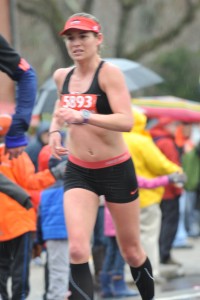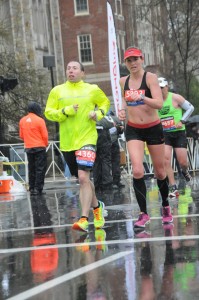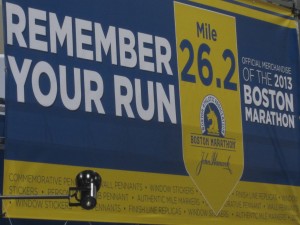 The Boston Marathon has been part of my marathon journey since my first marathon. Working towards a BQ (Boston Qualifier) gave my training a specific goal. Achieving that goal, and anticipating Boston was a magical experience. Three Boston Marathons later, and my journey seems somehow complete for that chapter. Before I get to that, let’s talk about the Boston Marathon for a minute.
The Boston Marathon has been part of my marathon journey since my first marathon. Working towards a BQ (Boston Qualifier) gave my training a specific goal. Achieving that goal, and anticipating Boston was a magical experience. Three Boston Marathons later, and my journey seems somehow complete for that chapter. Before I get to that, let’s talk about the Boston Marathon for a minute.
In my opinion, the Boston Marathon is the most famous, historical, and prestigious marathon in the world. I’m sure there are prettier marathon courses out there, harder ones, easier ones – but Boston is special. Unless you opt to run for a charity, every single runner on the course earns their way to the starting line by achieving a qualifying time. I like that. I’m someone who likes to work hard, and would never run Boston without earning my spot. Just my opinion. This is because that starting line and 26.2 mile journey cannot be nearly as sweet for someone who fundraised as someone who may have put blood, sweat, tears and sacrifice into achieving that qualifier. For many of us, its as close to an Olympic Qualifier, or Olympic Trials experience. I wouldn’t want to buy my way into that either.
Besides being earned, the course is amazing. There are a few quiet miles through Boston farm towns and suburbs, but they are short-lived and broken up by the most passionate fans and towns I have ever witnessed. In Monday’s rain, the crowds only screamed louder. You can hear the Wellesley girls (famous for giving out kisses to runners) a mile or so away. The energy is electric. The locals set up tents, fire pits, and parties in their front yards – often handing out orange slices, candy, tissues, water, and all the enthusiasm they have. By the time you get to the Newton Hills, you are charged and ready for the hills that await you. Turning the corner in Newton at the fire station, and seeing one of the first big climbs, you cannot help but feel confident and strong as Bostonians scream for you. From Brookline to the finish line on Boylston Street, the energy simply carries you.
If you have never run Boston, and have it on your list of goals, I highly recommend you do what you can to qualify. The reward for partaking in Patriot’s Day is one that cannot be accurately described. It’s an honor to share the journey with so many talented runners from around the world.
 The 2015 race took place in less than ideal weather. Off and on rain (sometimes a heavy pouring rain!) and 20 MPH winds at times meant respecting the weather and not fighting it. The rain held off for me until I got to Natick, so I was a good 6-8 miles into the race before the weather got nasty. Overall, I have to say the weather wasn’t bad. Had I been trying to race, I’m sure I would have felt it. Based on the slow elite times, it obviously was a factor. The worst part was losing feeling in my hands and arms, making opening my final GU a real challenge. But in the big picture, a pretty minor inconvenience.
The 2015 race took place in less than ideal weather. Off and on rain (sometimes a heavy pouring rain!) and 20 MPH winds at times meant respecting the weather and not fighting it. The rain held off for me until I got to Natick, so I was a good 6-8 miles into the race before the weather got nasty. Overall, I have to say the weather wasn’t bad. Had I been trying to race, I’m sure I would have felt it. Based on the slow elite times, it obviously was a factor. The worst part was losing feeling in my hands and arms, making opening my final GU a real challenge. But in the big picture, a pretty minor inconvenience.
I have had a hard time processing this past Monday. I almost bailed on the race all together. I didn’t know if I was truly ready to come back and face the course and the city for the first time since 2013. I won’t rehash the details, but you can read my blogs about that here, here and here. Ironically, though qualifying for Boston has never been full of misses and heartbreak (I’m lucky in that department!), my experiences in Boston had never been good. In 2012, the year it was over 80 degrees at the start, I was battling a stomach bug that forced me to DNF at my 11. It was a truly terrible day, and I was so heartbroken and sad. I had never pulled out of a race before, and Boston seemed like the worst of all races to do so. In 2013, I was coming back from an injury and wasn’t sure I’d be clear to go and run – I had abandoned the original goal of really racing and trying to PR. On what was a beautiful day, and an incredible journey with my friend Cipriana, that was all erased at the finish line. So this year, the third attempt at Boston, I was more or less waiting for something to go wrong. Maybe third year was the charm? Anyway, when the weather looked sour, I figured if that was the worst of it, I’d take it. I can run in wind and rain. I wasn’t aiming to PR or really race, and I train through any and all conditions.
Race weekend was tough. Anxiety made me snappy, tense, and probably hard to deal with. We avoided crowds, Boylston Street and pretty much everything. Aside from the race expo, which we got in and out as quickly as possible, we laid low. I turned off my phone by 7pm on Sunday night, and was in bed. I wasn’t exactly sleeping, but I was resting. This may be one of the first marathons where I was calm and not at all stressed about the course, race morning, goals – I am usually a bit of a basket case. Having no race goals and knowing the course meant I let it all go. It was really strange. The most I have ever slept before a marathon, for sure. Race morning, as soon as I left the hotel and started the walk towards Boston Commons for the bus, Boston PD were out with bomb sniffing dogs at 6am. I almost threw up, but somehow told myself not to panic. Thankfully, a lovely couple (Christina and Quint) came up beside me and started chatting as we walked. Having their company from that moment until we hopped into our corrals hours later was a mind-saver. Truly.
At the starting line, I was briefly overcome by emotion. Not because of PTSD or bad memories, but the reality that here I was, on the iconic starting line in Hopkinton. My plan for the day was to run a comfortable pace, and to settle and not burn out on the hills. Being a coach has made me a smarter athlete. I never lost my head or abandoned my plan. The quiet, the crowds, the rain, the wind, and calm – I took it all in. I looked forward to each town in front of me, and enjoyed the town I was in. I gave high-fives, pumped my fist when someone shouted “Go #5893!!!!,” took my GU like clockwork every 5 miles, and enjoyed the journey. While many runners around me dreaded the iconic hills between miles 16-21, I was excited to see them and climb them. I’m not going to say I was never tired out there, because 20 miles into a marathon nobody feels fresh – regardless of the pace. I recall my glutes and hips felt a little tight and tired, and I told myself “smooth and easy,” over and over each mile. Reminding myself to check my form meant I never took heavy steps – always silent or very quiet.
Getting to the top of HeartBreak is always fun – all of the Boston College kids and the fast downhill give you a surge. Plus it’s only 5 miles to the finish. This is where I started passing runners by the dozens. I found my even splits meant I passed many runners on the hills who had gone out too fast, but then the final 5 miles all I did was fish in runners who struggled. It’s a GREAT feeling to pass everyone towards the end of a race. Though I only looked at my watch periodically to make sure I wasn’t going too fast, I ran 1:38:57 for the first half, and a slightly positive split for a finish time of 3:20:23.
Chris was standing at the overpass he was at in 2013, wearing a poncho and trying to snap photos in the rain. Once I saw him, it was a block until the right turn on Hereford Street, and the quick left onto Boylston Street. On Hereford, I gathered myself for what was ahead. I remember briefly closing my eyes and closing out the world. I told myself this was it, the epic stretch was before me, and this time it was mine to celebrate without anything bad. I had made it to Boston, all I had left was Boyslton Street. Running down Boylston Street is something I cannot put into words. The energy is unfathomable. It’s all around you. I laughed, I cried, I opened up my stride to finish strong. I remember giving a second of reflection as I passed the National Flags, having witnessed them destroyed two years ago.
Once at the finish, I turned around and forced myself to look back. No bombs. No fear. Just cheering and runners coming in behind me. The rain and wind, though noticeable, was such a minor thing in the big picture. My frozen hands and arms had a hard time holding the water bottle handed to me, and a volunteer put my medal around my neck and helped me with my mylar poncho. My legs were so cold I couldn’t tell where my shorts stopped and my legs began. As I exited Boystlon Street and walked back to my hotel, I’m sure I looked like a mess. A drenched, crying, laughing, poncho-wearing runner looking at her splits and eagerly walking the mile or so back to a hot shower.
Some interesting facts/choices made that day:
- Pre-race, I consumed 1 banana at the hotel, and then 1 banana and 1 bagel, and 1 bottle of water in Athlete’s Village.
- No blisters, chafing or discomfort commonly associated with long distance running occurred during this marathon – which is pretty surprising considering the wet conditions.
- I used old running socks as mittens for my hands, and kept them on for the first 5 miles. They worked great.
- Wearing a hat with a cap is hugely helpful when racing in rainy or sunny conditions. The rain was rarely in my face and vision was never compromised.
- Usually one to race in sunglasses, I opted to leave them at the hotel. This worked out well, considering the humidity level and rain. Though my face did feel a little naked without them.
- After much debate, I opted to dress minimally for a chilly race – sports bra, shorts, knee high compression socks, and arm sleeves – which I discarded around 10 miles in. The minimal clothes meant minimal fabric weighed down by cold rain. The only downside: my arms/hands lost all feeling by the end of the race, thanks to the wind and rain.
- I used 4 GUs, taking them religiously every 5 miles. I stored them in my sports bra, my arm sleeves, and later held the final two in my hand after discarding the arm sleeves and looking to avoid chafing.
- I brought my iPod with me (incase nerves became a big issue), but never used it and had the headphones tucked into my sports bra the entire 26.2 miles.
- I never took any Gatorade, only water from hydration stations.
- Breaking up the course by town is a nice way to look at 26.2 miles. Boston is the perfect course for this strategy, as it’s pretty much a straight shot to Boston. No hairpin turns or out-and-backs.
- Once crossing the finish line, I kept moving. I paused for my medal and mylar sheet, but otherwise walked an additional 20 minutes or so. Resisting the temptation to stop and sit post-race can be hugely beneficial for recovery.
- I consumed a bottle of water, a burrito, chips and guacamole, and a chocolate shake within 60-90 minutes after walking back to the hotel. Fueling post-race is important, and I waited a little longer than the ideally recommended 30-minutes post-race. I was too cold and frozen to manage eating en route to the hotel. And it was pouring.

Three Patriot’s Days running Boston, and the third was certainly the best. I don’t know when I’ll be back. I’m okay with that. I have a qualifier now for 2016, but I don’t want to rush anything. Plus I don’t know what my goals are right now with the marathon. I’d love to come back and really race some day. I’d also love to crack 3 hours. Though I don’t know if Boston will be the place for that. For now, I am just relieved to have made it to today, with a positive story about the Boston Marathon. I will never forget 2013, as hard as I may try. And that’s okay, it’s unfortunately part of my history. But now I also have a newer history in Boston, that is so much sweeter.







